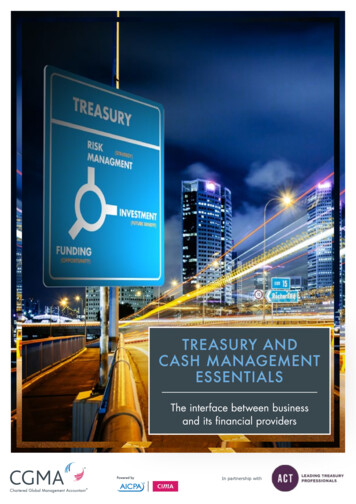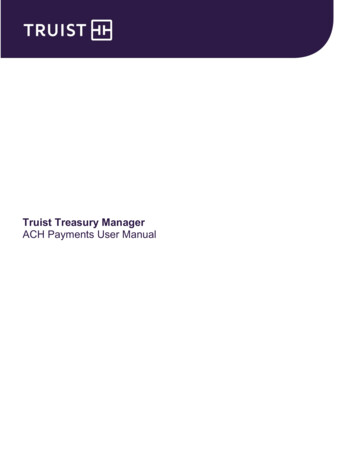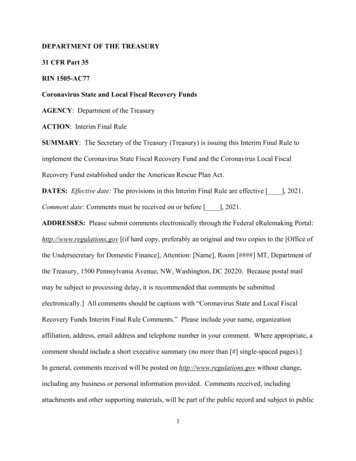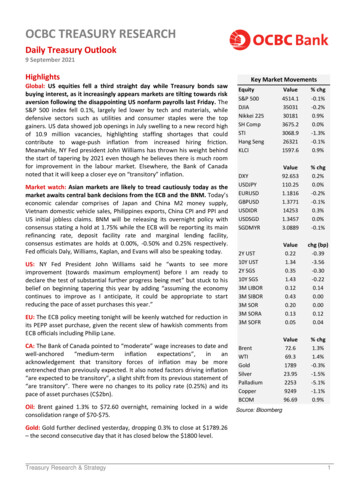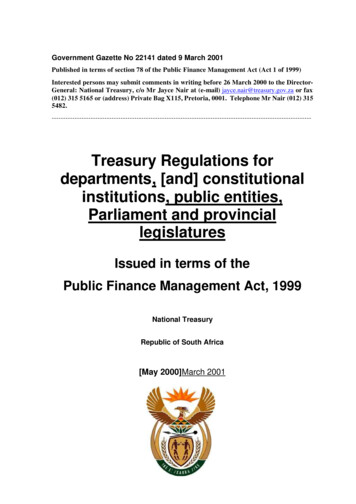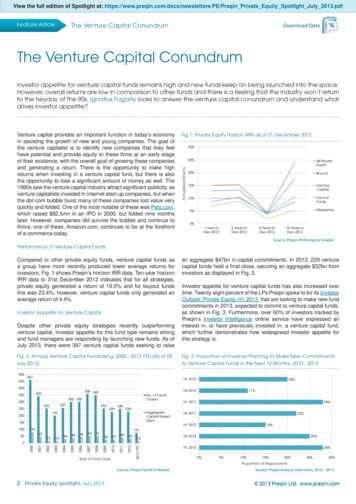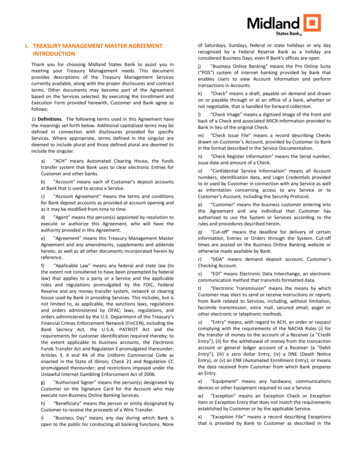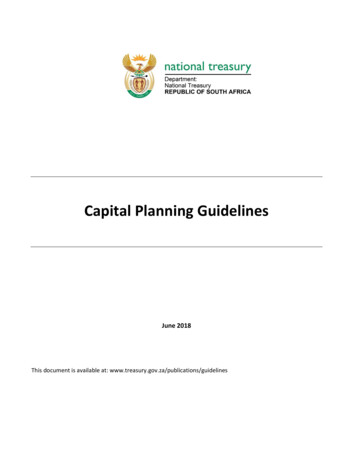
Transcription
Capital Planning GuidelinesJune 2018This document is available at: www.treasury.gov.za/publications/guidelines
Capital Planning Guidelines 2018 updateCONTENTSCapital Planning Guidelines . 11.INTRODUCTION . 32.PLANNING AND APPRAISAL PROCESS . 33.PREPARATORY WORK . 43.1 Needs and Demand Analysis . 43.2 Options Analysis . 44.3.2.1Demand Analysis . 53.2.1Technical Engineering Analysis . 53.2.2Environmental Analysis . 63.2.3Socio-economic Analysis . 63.2.4Legal and Regulatory Due Diligence . 7VIABILITY EVALUATION. 74.1Financial Analysis . 74.1.1Financial cash flow analysis . 74.2 Economic Analysis . 84.2.1Cost Benefit Analysis . 94.2.2Cost Effectiveness Analysis . 94.2.3Economic Impact Assessment . 104.3 Risk assessment and sensitivity analysis . 105.THE PREFERRED OPTION . 116.IMPLEMENTATION READINESS. 116.1Institutional Capacity . 116.2Procurement Plan . 112
Capital Planning Guidelines 2018 update1.INTRODUCTIONThe National Treasury provides these general capital planning guidelines to assist in the planning of capitalprojects. The guidelines are designed to ensure thorough planning of capital projects by encouragingconsideration of the life-cycle costs of projects. The guidelines emphasise the need for alignment betweendepartmental planning processes and relevant legislation such as the Immovable Asset Management Act(GIAMA) and the Infrastructure Development Act. The planning and appraisal of projects is expected to bea continuous process which takes place throughout the year.2.PLANNING AND APPRAISAL PROCESSDepartments are encouraged to have in place project planning and appraisal processes that are aligned totheir strategic planning, infrastructure planning and budget planning processes. The projects beingplanned may include new projects; extension of existing capital projects; refurbishment and replacementof assets. Although all capital projects need to undergo a systematic and rigorous appraisal, the type anddepth of information required will depend on the size and the nature of the project. The current projectsize definition is: Mega projects are those estimated to cost more than R400 million per year for a minimum of threeyears, or a total project cost of at least R1 billion. Most mega projects will customarily require a prefeasibility study and a comprehensive feasibility study for scrutiny by National Treasury. Large projects are those estimated to cost between R90 million and R400 million per yearfor a minimum of three years – totalling at least R250 million per year but less than R1 billionover the MTEF. Large projects require a feasibility study for scrutiny by National Treasury. Small projects are those estimated to cost less than R90 million per year and not more than R250million over the MTEF. Small projects with the same outputs should be grouped together in aprogramme for evaluation. Small projects will not be subject to detailed appraisal as requiredabove but they should illustrate that they have been properly planned and meet the identifiedneed and objectives of the institution.All projects extending beyond the MTEF period, regardless of medium-term funding needs, must outlinefuture funding requirements in the submission. Full project costs, including annual operating andmonitoring and evaluation costs over the lifetime of the asset, must be reportedResources spent on appraising capital project proposals should be proportional to the project cost, keepingin mind its nature and complexity. The guidelines also recognise the challenge institutions may face interms of skills and capacity. The appraisal activities may be outsourced, depending upon the capacityresident in an institution.All projects go through a series of distinct stages from the initial project idea to completion and then handover. It is important for institutions to understand these project stages and the analysis to be carried outat each stage. The analysis is an integral part to a logical approach to project planning that will assist in theappraisal of the project. The analysis will also provide the rationale or justification for government funding.3
Capital Planning Guidelines 2018 updateIt is important to ensure that maintenance costs are included in the life-cycle costs so that the value of theasset created is maintained. Direct maintenance costs will include the costs over the full project cycle ofmaintaining the assets in the condition required to deliver the specified outputs, and may include the costsof raw materials, tools and equipment, and labour associated with maintenance. The level of maintenanceassumed must be consistent with the forecasted capital costs and the operating cost.Appraisal of capital projects is not a straight forward step by step process where the different analyses areindependent from each other and can be performed in a perfectly sequential manner. Information willneed to flow between the different analyses and constant feed-back mechanisms need to be in place toensure the coherency of all the documentation.3.PREPARATORY WORK3.1Needs and Demand AnalysisThe needs analysis should demonstrate alignment with the institution’s mandate and strategic objectives.The purpose of this analysis is to enable the institution to clearly identify a clear infrastructure need,specify outputs of the project and ascertain the extent of current and future demand for the service.The analysis should describe: The problem that has given rise to the need for additional infrastructure, including an analysis of theexisting asset capacity; The extent and urgency of the need; The extent of the need this request is intended to meet; Output specifications that describe the service the institution needs to deliver, the requiredminimum standards of the service output as well as the specific key indicators to measureperformance; The data, surveys or service-delivery indicators demonstrating the current demand and estimatingthe future demand growth. The demand analysis cannot simply assume a continuation of a historictrend, but must demonstrate what long-term factors are driving demand, and how those trendsmay be shifting ; The consequences if the services infrastructure need is not addressed; How the proposed capital solution to the problem fits into the institution’s long term infrastructuredelivery programme.The output from this stage is a statement of the services infrastructure need, a specification of the outputrequirements and a sound demand analysis.3.2Options AnalysisThe purpose of an options analysis is to undertake an analysis of all feasible options that can achieve theidentified output specifications. This will assist in identifying the preferred solution.4
Capital Planning Guidelines 2018 updateThe following principles should guide the options analysis: All feasible options should be evaluated; The preferred option should achieve value for money1; The preferred option should be affordable; The analysis should consider those options crucial to a project’s success; and A scenario which sets out the base case (the ‘do nothing’ scenario) where the current situation issustained with minimal operating and maintenance investments and basic efficiency improvements.A first high-level analysis of these options should include a qualitative listing of the advantages anddisadvantages as well as preliminary quantification of the costs and benefits of each option relative to theobjectives of the project. This comparison should allow for the development of a shortlist of 1 to 2preferred options which will be assessed in detail.Each of the shortlisted options will be separately assessed by the processes described in the stages below.The information below needs to be assembled first to enable the undertaking of the Financial andEconomic analysis.3.2.1 Demand AnalysisThe first step is to confirm that there is demand for the goods and services that will be produced by theproject. This is important because levels of current and forecasted demand should be sufficient tocontribute to the viability of the project. Any factors that constraint demand need to be identified andfactored into the demand forecasts.The outcome of this analysis will give confidence to the following: Forecast quantities of demand (product/service) over the life of the project; Constraints such as government regulations (administered prices, ceilings, quotas includingarrangements for making future adjustments to prices); and Other variables that affect the volume of demand such as technological developments impacting on theproduct life cycle and subsidies.3.2.1 Technical Engineering AnalysisThis is an important step that determines the scale, the design, location and technology that will beadopted by the proposed project. The input parameters necessary for the construction, operation andmaintenance of the project are identified, quantified and the cost approximated over the life of the project.To be able to do this it is necessary to come up with an implementation schedule that sets the output1Value for money can be defined as a measure of economic efficiencies that achieves the best mix of quality andeffectiveness at least cost.5
Capital Planning Guidelines 2018 updatelevels. The most cost effective procurement procedures are also considered at this stage. The outcomes ofthe analysis include: The technology choice for the project including designs and prototypes; Project size and location; Construction schedule and output targets; Input parameters and their prices including labour for the construction and operation and maintenanceof the project; and Procurement procedures.For larger and technically more challenging projects, however, the technical assessment is crucial andneeds to be accomplished accurately and thoroughly. The technical feasibility will then inform the financialanalysis, by providing detailed clarification on the costs of construction, operation and maintenance of theproject and identifying potential risks. Different technology choices for the project, including designs andthe need for prototyping should be assessed to determine whether they will be viable for delivering thedesired project outputs. In addition, potential locations for the project should be assessed to determinetheir viability, including ownership, geological and heritage aspects.3.2.2 Environmental AnalysisEvery project involving new construction or substantial rehabilitation of an existing structure will involveundertaking an Environmental Impact Assessment (EIA). In those instances where the institution is goingto procure, by conventional means, the construction of a facility of its own design, the institution mustundertake the EIA and obtain all necessary environmental, zoning and town planning consents. The costof so doing is one of the costs that must be identified early on and quantified when determining thefeasibility of a particular project.Outcomes from this analysis include: The costs of, and time to obtain an Environmental Impact Analysis (EIA) report; Anticipated mitigation or displacement costs; and Other necessary approvals and permits.Identified costs and risks must be taken into account in the viability analysis. Institutions should note thatEIA can be very costly and can extend over a protracted period of time hence the need for an EIA shouldbe recognised early so that adequate budgetary provision can be made for such costs3.2.3 Socio-economic AnalysisMany services infrastructure projects provide potential economic benefits to Black EconomicEmpowerment (BEE) and Small Medium and Micro-sized Enterprises (SMME) as well as the community ingeneral. The implementation of a project can result in an increase in land values or in an increase indemand for affordable housing. The use of local labour and materials in a major infrastructure project also6
Capital Planning Guidelines 2018 updateprovides significant benefits to communities affected by the infrastructure project. There may also be costsnot easily realisable such as those resulting from congestion in the city caused by the implementation ofthe project. All these will need to be translated into economic costs and benefits.Outcomes from this analysis include: BEE participation including Women EmpowermentSMME ImpactLocal Preferential ProcurementCommunity DevelopmentJob Creation3.2.4 Legal and Regulatory Due DiligenceA legal and regulatory due diligence study should confirm that the project will be able to comply with allregulatory requirements, identify any risks and obligations that could increase costs of or decreasebenefits. The cost of compliance must be included in the financial and economic analysis.Typically the analysis will include an assessment of the following: Sector legislation, policies and regulations;Tax legislation;Labour legislation;Environmental legislation;Heritage legislation;BBBEE legislation and Codes of Good Practice;Local procurement requirements;Imported goods requirements;Foreign exchange requirements;Zoning and town planning requirements;Building codes;License requirements; andSite ownership and/or access approvals.4.VIABILITY EVALUATION4.1Financial Analysis4.1.1 Financial cash flow analysisThe objective of this analysis is to establish the financial viability of the option. The analysis is carried outin accordance with the discounted cash flow method. A financial model projecting the cash flows for thecosts and any revenue generated from the project over its lifetime is developed. This analysis needs to be7
Capital Planning Guidelines 2018 updateundertaken for each of the preferred options identified. If the institution lacks the capacity for developingsuch financial models, outsourcing this expertise should be considered. In order to preserve theoutsourcing option for future capital expenditure undertakings, the institution should budget for suchexpenditures.The financial model must be informed by all the life-cycle costs to deliver the identified outputs. The cashflow profile identifies all the receipts and expenditure over the life of the project. This is based on theoperating costs (including working capital requirements) and revenues; investment costs and residualvalue (in last year of project) and sources of financing (their characteristics and implications). All revenuesgenerated over the lifetime of the project must be projected, bearing in mind, where applicable, therequirements of the Public Finance Management Act (PFMA) requiring such revenues to be deposited intothe appropriate national or provincial revenue fund (sections 13 and 22). The result of this analysis is atimeline on which all cash flows over the project’s lifetime, both positive (i.e. revenues) and negative (i.e.expenditures) are demonstrated.By calculating the balances, discounted at an appropriate rate, it is possible to define a financial net presentvalue for the option that will determine its financial viability. The discount rate used in the calculations iswithin the discretion of the institution but it needs to be justified. However, it’s advisable to use thegovernment bond yield as the discount rate over a comparable period as it reflects the actual cost togovernment of raising funds at any given time.The financial analysis must also determine the minimum net cash flow requirement over the life of project.This must include life-cycle capital or construction costs as well as the annual operating and maintenancecosts. This will demonstrate that the option is financially sustainable and will not require supplementaryfunding. If the proposed option is not financially viable, it is important to check whether it is viable froman economic and social point of view. If it is, then consideration must be given to other sources ofadditional funding.Since capital projects are long-term in nature, there is uncertainty with regards to some of the assumptionsused in the calculation of costs and revenues. Costs should be readjusted to reflect different scenariosbased upon variations in key assumptions – e.g. what is the effect of a 10% increase in costs, or what is theeffect on the cost of imported inputs if there is 5% devaluation in the exchange rate? This is an essentialpart of the capital bid as it will assist the project planners to be aware of how costs vary with changes inthe underlying assumptions.4.2Economic AnalysisAn economic analysis is different from a financial analysis in that it analyses the viability of a project basedupon economic and social welfare improvements, and not financial bankability. An economic analysis thustakes non-monetary welfare impacts into account, such as improved health, reduced accident risks,congestion and pollution.All mega projects with a total project cost of R1 billion or more will need to undertake either a cost-benefitanalysis or a cost-effectiveness analysis (CEA) for each of the preferred options. Generally, the cost-benefitanalysis is more appropriate for economic infrastructure projects, e.g. transport, water, energy and8
Capital Planning Guidelines 2018 updatecommunications sector projects, whereas a CEA will be more appropriate for social infrastructure projects,e.g. health, and education.4.2.1 Cost Benefit AnalysisDifferent methodologies are available for analysing the economic viability of a project; the most commonone is the Cost Benefit Analysis (CBA). A CBA seeks to establish whether a particular investment is the mostefficient use of society’s resources. It does this by identifying and monetising the costs and the benefits tosociety to enable comparison.Unlike in the financial analysis, the market prices of the project inputs and outputs do not necessarilyreflect the values of economic costs and benefits when there are distortions in the market place. In reality,many distortions prevail in the economy of South Africa, including taxes and subsidies. Therefore, theyshould be properly assessed and incorporated in the economic appraisal. The CBA translates all financialtransactions (i.e., receipts and expenditures) into benefits and costs in order to reflect the true benefitsand costs to the society as a wholeA conversion factor can be created as the ratio of the economic value of an item to its correspondingfinancial price. Once these are estimated then the financial receipts or costs of each item can be convertedinto their economic values by multiplying them by corresponding conversion factors. These values are thendiscounted back to their present values using a social discount rateThe result of a CBA is best reported in the form of an Economic Net Present Value (ENPV). If the economicnet present value of the project is greater than zero, the project is worthwhile to implement because theproject would generate more net economic benefits than if the resources had been used elsewhere in theeconomy. On the other hand, if the net present value is less than zero, the project should be rejected onthe ground that the resources invested could be put to better use in the next best alternative use.Every preferred option will be subject to this approach. The result will then be a comparison of every optionwith the base case “do-nothing” scenario and a ranking of the different options in accordance to their netwelfare benefit to society.4.2.2 Cost Effectiveness AnalysisCost-effectiveness studies are appropriate where project options must be compared but assigning amonetary value to the desired outcome would not be appropriate. This usually applies to projects that donot represent an economic activity, such as social, health or human rights projects, and where a needsanalysis has been informed by a defined social requirement.Decision-making in these cases is focused on finding the solution that is the most efficient in realising thedesired project outputs. The CEA examines the costs of a project in exactly the same manner as a CBA.However, the benefits are described in a very specific non-monetised way such as ‘number of HIV testsconducted’ or ‘number of lives saved per year’ or ‘number of children vaccinated’. The results are thenpresented as the cost per ‘unit’ of benefit (1 HIV test, 1 life saved, or 1 child vaccinated). The project withthe best ratio is the one with the optimal scale that uses the resources the most efficiently. In certain9
Capital Planning Guidelines 2018 updateoccasions however, there is a particular threshold (minimum of 10.000 vaccinations) that needs to bereached before comparing projects on the efficiency ratio.The CEA allows institutions to assess projects without having to monetise social benefits.4.2.3 Economic Impact AssessmentOnce the viability of one or more project options has been demonstrated through CBA or CEA, it may benecessary to do further analysis to identify the macro-economic growth effects, spill-over effects, ordistributional impacts.If the proposed project is so large, capital intensive or import reliant that it might influence national orsectorial GDP, the balance of payments or the exchange rate, a macro-economic impact assessment isrequired.If the project has the potential to affect a particular social group, a region or a sector, a micro-economicimpact assessment is required. The assessment allows for the identification of the losers and the winnersfrom the project and the judgement of whether these distributional impacts are aligned with governmentpriorities. If the potential losers are identified as an already vulnerable group, this might require mitigationactions to be undertaken. The project’s scope and financial structure must be aligned towards the findingsin the impact assessment.The results of these impact assessments can assist in prioritising viable projects on the basis of otherdevelopmental goals such as impact on rural or regional development, industrial expansion, potential forjob creation or losses, or reduction in inequality; or for large projects, and their impact on exchange rates,balance of payments, inflation, and GDP growth.4.3 Risk assessment and sensitivity analysisThe outcomes of both the financial and economic analysis are based on certain modelling assumptions andrisk predictions. These assumptions need to be scrutinised and tested to ensure that the project remainsviable even in an environment which differs significantly from that assumed in the various analysesconducted.Large projects with significant technical, financial and economic risk are required to undergo a qualitativeas well as quantitative risk assessment. Smaller projects with limited technical or contextual risk, mustattempt to draw up a risk matrix where all the potential risks are listed and the likelihood and impact of theidentified risk on the project is qualitatively described and controls or mitigating actions identified.A risk assessment looks at all risks related to a project and assesses the impact of these risks and if mitigatingactions are possible. For certain projects where uncertainty is significant and involves large financial risks,presenting a risk-adjusted costing model is crucial. Costing for risks is then undertaken by identifying all therisks, approximating the financial impact they will have on project costs and revenues and estimating theprobability of occurrence of the risk event.10
Capital Planning Guidelines 2018 updateA sensitivity analysis tests the impact of changes in various modelling assumptions on the viability of theproject. After the financial model has been finalised, sensitivity analyses need to be undertaken in orderto determine the resilience of the cash flows to changes in assumptions over the project’s life-cycle.Adjusting each variable individually by a given percentage and then stress-testing project viability willhighlight which assumptions are the most vulnerable. The impact of changes in these assumptions on theFNPV and ENPV should be determined.5.THE PREFERRED OPTIONHaving identified and thoroughly evaluated the options that may provide a solution to the identified need,it is important to now quantify the cost of the shortlisted options that will most nearly provide a completesolution, in order to select a preferred option for funding. The aim is to identify the best solution that willmeet the criteria given any constraints the institution may be facing. The result is a clear reasoning as towhy and how the preferred option was chosen. The preferred option is the option that meets the projectobjectives most economically.6.IMPLEMENTATION READINESS6.1Institutional CapacitySufficient capacity to deliver the project on time, on budget and to specifications should be demonstratedclearly. An institutional arrangement that is conducive to effective delivery is critical. Analysis to ensurethat the institutions responsible for implementation, including project management, and operationalresponsibility will be appropriate to the task, should demonstrate that: Institutions have an appropriate mandate; Suitable incentives or penalties are in place to ensure delivery; Accountability, transparency and appropriate risk allocation are guaranteed; There are no governance issues that may affect implementation; and The relevant institutions have, or can access, the required capacity.If necessary, a plan for institutional capacity building can be included in this analysis. This includes sufficientplanning, procurement and skills transfer of the required technical expertise. Options for enhancingimplementation potential include in-house training as well as various forms of partnering with the privatesector.6.2Procurement PlanA procurement plan for the project must be identified. The plan needs to demonstrate that the proposedprocurement method is the most appropriate for the project and will result in achievement of the targetedoutcomes. This includes indicating the procurement methodology that will be employed and how it will be11
Capital Planning Guidelines 2018 updatemanaged. The procurement plan will also include a high-level project plan, key milestones and timelinesas well as the envisaged institutional and financial arrangements.12
Capital Planning Guidelines 2018 update 3 1. INTRODUCTION The National Treasury provides these general capital planning guidelines to assist in the planning of capital projects. The guidelines are designed to ensure thorough planning of capital projects by encouraging consideration of the life-cycle costs of projects.
